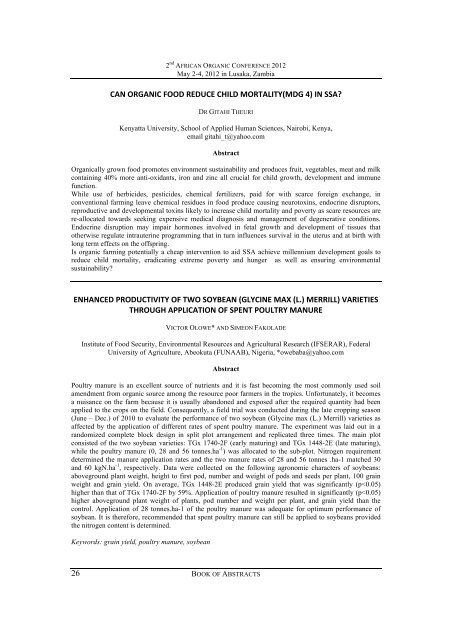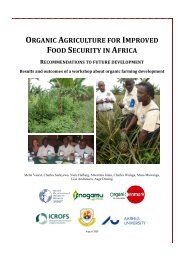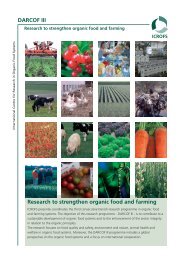The 2nd African Organic Conference â Mainstreaming ... - ICROFS
The 2nd African Organic Conference â Mainstreaming ... - ICROFS
The 2nd African Organic Conference â Mainstreaming ... - ICROFS
You also want an ePaper? Increase the reach of your titles
YUMPU automatically turns print PDFs into web optimized ePapers that Google loves.
2 nd AFRICAN ORGANIC CONFERENCE 2012<br />
May 2-4, 2012 in Lusaka, Zambia<br />
CAN&ORGANIC&FOOD&REDUCE&CHILD&MORTALITY(MDG&4)&IN&SSA?&<br />
DR GITAHI THEURI<br />
Kenyatta University, School of Applied Human Sciences, Nairobi, Kenya,<br />
email gitahi_t@yahoo.com<br />
Abstract<br />
<strong>Organic</strong>ally grown food promotes environment sustainability and produces fruit, vegetables, meat and milk<br />
containing 40% more anti-oxidants, iron and zinc all crucial for child growth, development and immune<br />
function.<br />
While use of herbicides, pesticides, chemical fertilizers, paid for with scarce foreign exchange, in<br />
conventional farming leave chemical residues in food produce causing neurotoxins, endocrine disruptors,<br />
reproductive and developmental toxins likely to increase child mortality and poverty as scare resources are<br />
re-allocated towards seeking expensive medical diagnosis and management of degenerative conditions.<br />
Endocrine disruption may impair hormones involved in fetal growth and development of tissues that<br />
otherwise regulate intrauterine programming that in turn influences survival in the uterus and at birth with<br />
long term effects on the offspring.<br />
Is organic farming potentially a cheap intervention to aid SSA achieve millennium development goals to<br />
reduce child mortality, eradicating extreme poverty and hunger as well as ensuring environmental<br />
sustainability?<br />
ENHANCED&PRODUCTIVITY&OF&TWO&SOYBEAN&(GLYCINE&MAX&(L.)&MERRILL)&VARIETIES&<br />
THROUGH&APPLICATION&OF&SPENT&POULTRY&MANURE&<br />
VICTOR OLOWE* AND SIMEON FAKOLADE<br />
Institute of Food Security, Environmental Resources and Agricultural Research (IFSERAR), Federal<br />
University of Agriculture, Abeokuta (FUNAAB), Nigeria, *owebaba@yahoo.com<br />
Abstract<br />
Poultry manure is an excellent source of nutrients and it is fast becoming the most commonly used soil<br />
amendment from organic source among the resource poor farmers in the tropics. Unfortunately, it becomes<br />
a nuisance on the farm because it is usually abandoned and exposed after the required quantity had been<br />
applied to the crops on the field. Consequently, a field trial was conducted during the late cropping season<br />
(June – Dec.) of 2010 to evaluate the performance of two soybean (Glycine max (L.) Merrill) varieties as<br />
affected by the application of different rates of spent poultry manure. <strong>The</strong> experiment was laid out in a<br />
randomized complete block design in split plot arrangement and replicated three times. <strong>The</strong> main plot<br />
consisted of the two soybean varieties: TGx 1740-2F (early maturing) and TGx 1448-2E (late maturing),<br />
while the poultry manure (0, 28 and 56 tonnes.ha -1 ) was allocated to the sub-plot. Nitrogen requirement<br />
determined the manure application rates and the two manure rates of 28 and 56 tonnes .ha-1 matched 30<br />
and 60 kgN.ha -1 , respectively. Data were collected on the following agronomic characters of soybeans:<br />
aboveground plant weight, height to first pod, number and weight of pods and seeds per plant, 100 grain<br />
weight and grain yield. On average, TGx 1448-2E produced grain yield that was significantly (p





